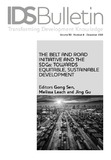The China–Pakistan Economic Corridor: A Case Study
| dc.contributor.author | Hyder Sayed, Mustafa | |
| dc.coverage.spatial | China | en |
| dc.coverage.spatial | Pakistan | en |
| dc.date.accessioned | 2019-12-17T11:47:56Z | |
| dc.date.available | 2019-12-17T11:47:56Z | |
| dc.date.issued | 2019-12-17 | |
| dc.identifier.citation | Hyder Sayed, M. (2019) 'The China–Pakistan Economic Corridor: A Case Study' in Sen, G., Leach, M. and Gu, J. (Eds) The Belt and Road Initiative and the SDGs: Towards Equitable, Sustainable Development, IDS Bulletin 50.4, Brighton: IDS | en |
| dc.identifier.uri | https://opendocs.ids.ac.uk/opendocs/handle/20.500.12413/14890 | |
| dc.description.abstract | The China–Pakistan Economic Corridor (CPEC) is a multifaceted project which was formally announced during a visit by China’s president, Xi Jinping, to Pakistan in April 2015. It is an infusion of infrastructure, energy, ports, railway networks, and people-centric projects, which enhance Pakistan’s trade connectivity, export potential, and geopolitical relevance. Pakistan and China believe that the CPEC will not only complement the economic development of the two countries but will also bring peace and prosperity in less developed regions of Pakistan. The article focuses on the impact of CPEC projects comprising early harvest projects, middle and long-term plans, and social sector development initiatives including: poverty alleviation, clean water, health, education, vocational training, and agriculture. It also gauges the prospects and challenges faced by the CPEC and policy recommendations to make this project sustainable and inclusive. | en |
| dc.description.sponsorship | Center for International Knowledge on Development’s (CIKD) China–UK Partnership Programme on Knowledge for Development. | en |
| dc.language.iso | en | en |
| dc.publisher | Institute of Development Studies | en |
| dc.relation.ispartofseries | IDS Bulletin;50.4 | |
| dc.rights | This is an Open Access article distributed under the terms of the Creative Commons Attribution Non Commercial 4.0 International licence (CC BY-NC), which permits use, distribution and reproduction in any medium, provided the original authors and source are credited, any modifications or adaptations are indicated, and the work is not used for commercial purposes. http://creativecommons.org/licenses/by-nc/4.0/legalcode | en |
| dc.rights.uri | http://creativecommons.org/licenses/by-nc/4.0/ | en |
| dc.subject | Development Policy | en |
| dc.subject | Sustainable Development Goals | |
| dc.title | The China–Pakistan Economic Corridor: A Case Study | en |
| dc.type | Article | en |
| dc.rights.holder | Institute of Development Studies | en |
| dc.identifier.team | Business, Markets and the State | en |
| dc.identifier.doi | 10.19088/1968-2019.142 | |
| dcterms.dateAccepted | 2019-12-17 | |
| rioxxterms.funder | Default funder | en |
| rioxxterms.identifier.project | Default project | en |
| rioxxterms.version | VoR | en |
| rioxxterms.funder.project | 9ce4e4dc-26e9-4d78-96e9-15e4dcac0642 | en |
Files in this item
This item appears in the following Collection(s)
Except where otherwise noted, this item's license is described as This is an Open Access article distributed under the terms of the Creative Commons Attribution Non Commercial 4.0 International licence (CC BY-NC), which permits use, distribution and reproduction in any medium, provided the original authors and source are credited, any modifications or adaptations are indicated, and the work is not used for commercial purposes. http://creativecommons.org/licenses/by-nc/4.0/legalcode


